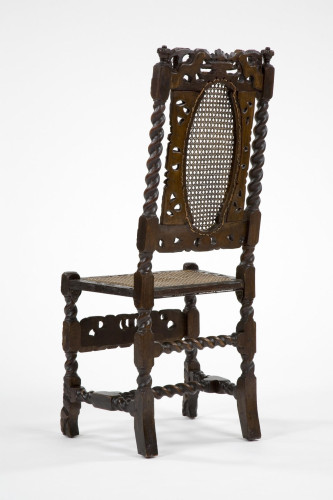45/2006-1
Collection
Furniture
Brief description
One of a set of six caned chairs, with a twist-turned and carved walnut frame and caned seat and back, made in England c.1685-1700.
Object name
chair
Object number
45/2006-1
Location
On Display
Production date
c.1685-1700 (manufactured)
Production place
England (manufactured)
Period
Stuart (1603-1714)
Material
walnut
cane
beech
varnish
metal
cane
beech
varnish
metal
Technique
turned
joined
carved
caned
varnished
pegged
screwed
joined
carved
caned
varnished
pegged
screwed
Physical description
Walnut and cane chair, with a twist-turned frame, the back with an oval caned panel within a leaf-carved frame with a ‘boyes and crowns’ crest rail, the trapezoidal caned seat with rails leaf-carved in shallow relief, on twist-turned legs with carved three-toed fore-feet, joined by a ‘boyes and crowns’ fore-rail and twist turned stretchers.
All the joints are mortise and tenon; the joints are pegged at the crest rail and back posts, the side seat rails to the front and back legs, the back stretcher to the back legs, and the side stretchers to the front and back legs. The finish is dark, and the wood is heavily disguised by a thick varnish. There is extensive worm damage overall, particularly to the back frame and seat rails. The cane to the back and seat have been replaced. The back frame has repairs; the crest rail has been repaired and strengthened at both ends with a splint screwed to the back of the rail; both vertical elements of the back frame have been similarly strengthened. A curved strip of wood has been screwed to the inner edge of the back panel to reinforce the edge drilled for caning.
The seat rails appear to be original. The front and back seat rails are made from beech, while the left and right rails are walnut. All four rails have been reinforced with strips of wood applied to their inner edges; all four have also been reinforced by screwed metal brackets running the full length of the rail and extending about 45 mm down each leg. The pegs securing the joint between the crest rail and back uprights are not old; it is not clear whether this joint was pegged originally. The pegs at seat level and stretcher level have been replaced. The back right heel has been spliced and tipped; both front feet have been spliced and tipped at the rear.
All the joints are mortise and tenon; the joints are pegged at the crest rail and back posts, the side seat rails to the front and back legs, the back stretcher to the back legs, and the side stretchers to the front and back legs. The finish is dark, and the wood is heavily disguised by a thick varnish. There is extensive worm damage overall, particularly to the back frame and seat rails. The cane to the back and seat have been replaced. The back frame has repairs; the crest rail has been repaired and strengthened at both ends with a splint screwed to the back of the rail; both vertical elements of the back frame have been similarly strengthened. A curved strip of wood has been screwed to the inner edge of the back panel to reinforce the edge drilled for caning.
The seat rails appear to be original. The front and back seat rails are made from beech, while the left and right rails are walnut. All four rails have been reinforced with strips of wood applied to their inner edges; all four have also been reinforced by screwed metal brackets running the full length of the rail and extending about 45 mm down each leg. The pegs securing the joint between the crest rail and back uprights are not old; it is not clear whether this joint was pegged originally. The pegs at seat level and stretcher level have been replaced. The back right heel has been spliced and tipped; both front feet have been spliced and tipped at the rear.
Dimensions
Height: 115cm
Width: 49cm
Width: 49cm
Website keywords
seating
Label
Label text for ‘New ways of living’ case, Information Bay 2, Geffrye Museum, 2010:
Cane chair, about 1685
Walnut frame with cane seat and back
Cane chairs, as they were called, were made in London from around 1670. They became fashionable amongst the middling sort, and by the 1690s were the dominant type of seating in parlours and dining rooms, replacing turkey-work chairs. The cane, or rattan, was imported from Asia.
Their cane panels and elaborate carving made them less robust than turkey-work chairs and they were cheaper because they were not upholstered. They seem to represent a shift in the tastes and values of the middling sort, as their stylish appearance became more desirable than durability.
Purchased with the support of the MLA/V&A Purchase Grant Fund
Cane chair, about 1685
Walnut frame with cane seat and back
Cane chairs, as they were called, were made in London from around 1670. They became fashionable amongst the middling sort, and by the 1690s were the dominant type of seating in parlours and dining rooms, replacing turkey-work chairs. The cane, or rattan, was imported from Asia.
Their cane panels and elaborate carving made them less robust than turkey-work chairs and they were cheaper because they were not upholstered. They seem to represent a shift in the tastes and values of the middling sort, as their stylish appearance became more desirable than durability.
Purchased with the support of the MLA/V&A Purchase Grant Fund


















